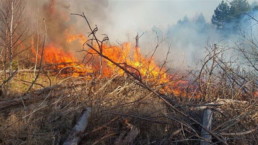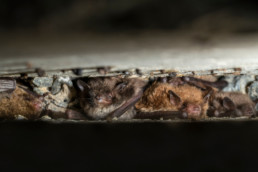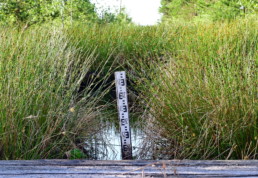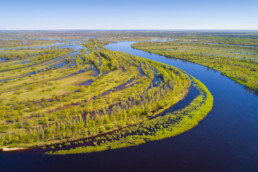Numbers matter: the densities of lynx populations in Polesia have been calculated for the first time
The Eurasian lynx (Lynx lynx) is one of the key large carnivores in Polesia. Despite its high conservation importance, the Polesian populations of this species are very poorly studied. The unprecedented camera trapping survey carried out in 2020-2021, and supported by our project provided the first scientifically based assessment of the Eurasian lynx population density in Polesia's protected areas. This paves the way for further research into the status of the species in the region, as well as its effective conservation locally and across its range.
The Eurasian lynx is widely distributed across the continent, with relatively stable numbers and legal protection in many countries, but is still threatened by anthropogenic factors such as habitat fragmentation and illegal hunting. It is therefore necessary to assess the status of populations across the species’ range in order to coordinate conservation efforts and make them effective. Currently, the Eurasian lynx is being studied unevenly across its range. In many European countries, lynx populations are systematically monitored using widely recognised scientific methods. At the same time, data on lynx abundance and density are scarce in Ukraine and Belarus, despite the fact that the species is protected in these countries.
In both Belarus and Ukraine, lynx are counted by hunting communities and forestry departments, but these efforts are neither systematic nor scientifically based. Double counting is common, making the estimates inaccurate. As well as provoking conflict between stakeholders, an inaccurate assessment of the status of a species can lead to inappropriate action. For example, the hunting community in Belarus is lobbying for a binary status for the lynx, which would keep the species in the Red Data Book but allow it to be hunted. They argue that lynx numbers are increasing significantly. However, there is no scientific evidence to this statement.
Correctly estimating the number and density of Eurasian lynx in is crucial, as the local populations are of high conservation importance, linking the species’ populations in Central and Eastern Europe. A large-scale survey supported by our project is the first attempt to fill this information gap.
From October 2020 to March 2021, an extensive camera trapping survey for lynx was carried out in three biodiversity hotspots in Ukraine and Belarus – Skolivski Beskydy National Park in Ukrainian Carpathians, the Ukrainian Chornobyl Exclusion Zone (UCEZ). and three adjacent protected areas and a state forest in Belarusian Pripyat Polesia (BPP). The last two mentioned areas are located in Polesia. 65 and 50 trapping sites were surveyed in the UCEZ and BPP respectively.
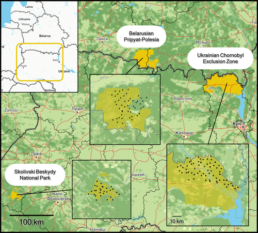
To determine population densities, Palmero et al. (2023) used the well-established spatial capture-recapture (SCR) method, which incorporates fine-scale spatial information associated with individual detections into population models. They found that the Eurasian lynx densities within the study areas varied from 0.45 to 1.54 individuals/100 km2, with the highest numbers in the Chornobyl Exclusion Zone. This is similar to other study areas in Europe where the same indices were determined using the same methods. The researchers suggest that the higher density of lynx in the CEZ is due to its large area, abundance of prey and low anthropogenic pressure, while in the Belarusian Pripyat Polesia the population faces lower habitat quality and prey abundance, as well as a higher risk of mortality due to poaching.
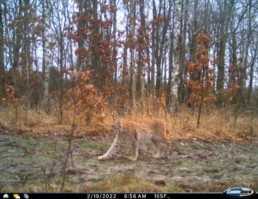
The work carried out and the results obtained are groundbreaking for both Belarus and Ukraine, and serve as a basis for further research on local Eurasian lynx populations and their conservation. It is also an important contribution to understanding the status of the species at the European level. The authors of the study point out that the data obtained will be important for future assessments of the impact of threats on the populations studied. They also suggest that protected areas play an important role in the conservation of the Eurasian lynx. Although large carnivores easily move beyond the boundaries of nature reserves or national parks, these protected areas still serve as refugia for the animals.
The authors emphasise that consistent, science-based monitoring of the Eurasian lynx, using the same methods across the continent, is key to understanding the species’ status and planning effective conservation measures.
Palmero, S., Smith, A. F., Kudrenko, S., Gahbauer, M., Dachs, D., Weingarth-Dachs, K., Kashpei, I., Shamovich, D., Vyshnevskiy, D., Borsuk, O., Korepanova, K., Bashta, A.-T., Zhuravchak, R., Fenchuk, V., & Heurich, M.(2023). Shining a light on elusive lynx: Density estimation of three Eurasian lynx populations in Ukraine and Belarus. Ecology and Evolution, 13, e10688. https://doi.org/10.1002/ece3.10688
The project “Polesia – Wilderness Without Borders” is part of the Endangered Landscapes & Seascapes Programme and is funded by Arcadia. The project is coordinated by Frankfurt Zoological Society (FZS).
This post is also available in UKR.


